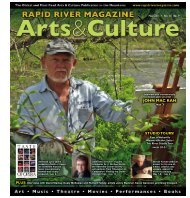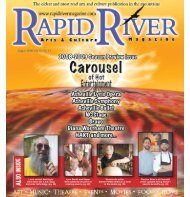winners of our annual poetry contest - Rapid River Magazine
winners of our annual poetry contest - Rapid River Magazine
winners of our annual poetry contest - Rapid River Magazine
Create successful ePaper yourself
Turn your PDF publications into a flip-book with our unique Google optimized e-Paper software.
R A P I D R I V E R A R T S & C U L T U R E M A G A Z I N E<br />
thoreau’s garden<br />
Green in Winter: The Horsetails<br />
The horsetails, or members <strong>of</strong> the<br />
genus Equisetum, are the direct<br />
descendents <strong>of</strong> plants that grew on<br />
earth millions <strong>of</strong> years ago during<br />
the Carboniferous Period <strong>of</strong><br />
geologic time. The vast American coalfields<br />
were formed as mounds <strong>of</strong> this and other<br />
vegetation sank ever deeper into the mire<br />
and through chemical action<br />
eventually became great veins<br />
<strong>of</strong> coal.<br />
At that time in earth’s<br />
history, dragonflies sported<br />
f<strong>our</strong>teen-inch wingspans<br />
and flitted about misty<br />
swamps, alighting on ferns<br />
with fronds that rose thirty<br />
feet into a sky that sported<br />
scuttling clouds and smoke<br />
from a legion <strong>of</strong> volcanoes.<br />
And, I might add, a long time<br />
before the dinosaurs roamed<br />
the planet.<br />
Today horsetails have<br />
diminished in size, the largest<br />
rarely topping six feet and the<br />
smallest measured in inches.<br />
The scientific name is from<br />
the Latin, equus, a horse, and<br />
seta, a bristle, referring to<br />
the plant’s resemblance to a<br />
horse’s tail, especially when<br />
many <strong>of</strong> the species produce<br />
stems covered with whorled<br />
branchlets. The species name<br />
<strong>of</strong> hyemale means “like<br />
winter” this time pointing<br />
out the absence <strong>of</strong> leaves on<br />
the stems. Horsetails grow<br />
along streams, lakes, ditches,<br />
and the edges <strong>of</strong> old railroad<br />
beds.<br />
Evergreen shoots grow from a perennial<br />
rhizome and have such high silica<br />
content that in pioneer days they were used<br />
to clean and polish pots and pads. Railroad<br />
cooks would use a bunch <strong>of</strong> stems to clean<br />
up the breakfast frying pan (rail workers<br />
ate heartily way back then), finally tossing<br />
soiled stems out the caboose window hence<br />
Illustration by Peter Loewer<br />
these plants are found growing<br />
along gravel and chipped<br />
stone railroad beds throughout<br />
the country.<br />
The cone-like caps that<br />
top the ringed stems produce<br />
spores, not seeds, and follow<br />
a complicated reproductive<br />
cycle like the ferns. Spores<br />
produce small, green, lobed<br />
prothalli that manufacture<br />
both male and female cells,<br />
which eventually meet to<br />
create a new plant. The tiny pennants that<br />
circle the rings, which in turn section <strong>of</strong>f<br />
the stems (they can be pulled apart just<br />
like poppit beads), are primitive, scale-like<br />
leaves, so the major part <strong>of</strong> photosynthesis<br />
occurs in the stem.<br />
The common horsetail (Equisetum<br />
hyemale) does quite well in a pot where<br />
it can spend the summer in the pool or at<br />
the water’s edge. If you plant them directly<br />
in the garden, be warned that they spread<br />
with amazing energy, each piece <strong>of</strong> a plant’s<br />
rhizome capable <strong>of</strong> creating a new plant.<br />
When bounded by an impenetrable barrier,<br />
these plants make a fascinating ground<br />
cover unlike any other plant on the market.<br />
There’s a gigantic super market called Jungle<br />
Jim’s, in Hamilton, Ohio where the road to<br />
Peter examines the<br />
blossoms <strong>of</strong> earlyblooming<br />
Lenten roses.<br />
BY PETER LOEWER<br />
the parking lot is a divided<br />
highway. Guess what the<br />
landscape architects used as<br />
a maintenance-free plant for<br />
the median? Why common<br />
horsetail <strong>of</strong> c<strong>our</strong>se. Plant<br />
height averages about three<br />
feet but can range up to five<br />
feet. Provide wet and fertile<br />
soil in full sun. Propagate by<br />
division most any time <strong>of</strong> the year. Horsetails<br />
are hardy far up into Canada.<br />
Equisetum hyemale ‘Robustum’ is an<br />
American cultivar, <strong>of</strong>ten growing to a height<br />
<strong>of</strong> seven feet. When members <strong>of</strong> the local<br />
Ikebana Society visit <strong>our</strong> garden, everybody<br />
wants a sample <strong>of</strong> this giant.<br />
Equisetum scirpoides is the dwarf<br />
scouting rush with threadlike stems about<br />
three inches high. It makes a great groundcover<br />
and does well in pots. Like other<br />
members <strong>of</strong> this clan, it’s also invasive.<br />
Peter Loewer is a well-known writer<br />
and botanical artist who has written and<br />
illustrated over twenty-five books on natural<br />
history over the past thirty years.<br />
Before You Go Outside<br />
The Historic Johnson<br />
Farm presents<br />
a class led by Gary<br />
Eblen, the Community<br />
Outreach<br />
Coordinator for<br />
Diamond Brand<br />
Gary Eblen<br />
Outdoors. The class<br />
will include helpful<br />
hints, tips and ideas to make y<strong>our</strong> camping,<br />
hiking and outdoors experiences a pleasure.<br />
The class is suitable for adults and students<br />
ages 12 and older.<br />
Eblen says: “My goal for this ‘class’ will<br />
be to enc<strong>our</strong>age people to ‘go outside and<br />
play’ in <strong>our</strong> own backyard whether it be a<br />
day hike, car camp or backpack trip. I’ll <strong>of</strong>fer<br />
suggestions on gear, food, books, maps that<br />
are now available that will help make their<br />
outdoor experience simple and fun. The emphasis<br />
will be on people ‘finding their own<br />
level <strong>of</strong> adventure.’ At Camp Mondamin (in<br />
Henderson County where Eblen worked<br />
many years), we <strong>of</strong>ten heard Chief (Frank<br />
Bell Sr., the camp owner) define adventure<br />
as ‘activity on one’s personal frontier.’”<br />
IF<br />
YOU<br />
GO<br />
Before You Go Outside will<br />
be held Monday, February 22<br />
at 7 p.m. at Historic Johnson<br />
Farm’s Interpretive Center.<br />
Cost is $5 per person. Pre-registration<br />
is suggested. The farm is located<br />
at 3346 Haywood Road, Hendersonville,<br />
NC, across from Rugby Middle School. For<br />
more information phone (828) 891-6585 or<br />
visit www.historicjohnsonfarm.org.<br />
Vol. 13, No. 6 — RAPID RIVER ARTS & CULTURE MAGAZINE — February 2010 17
















